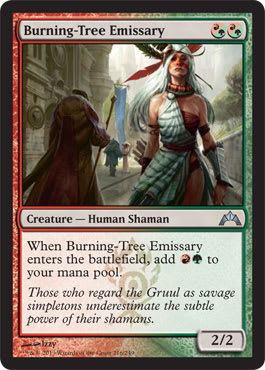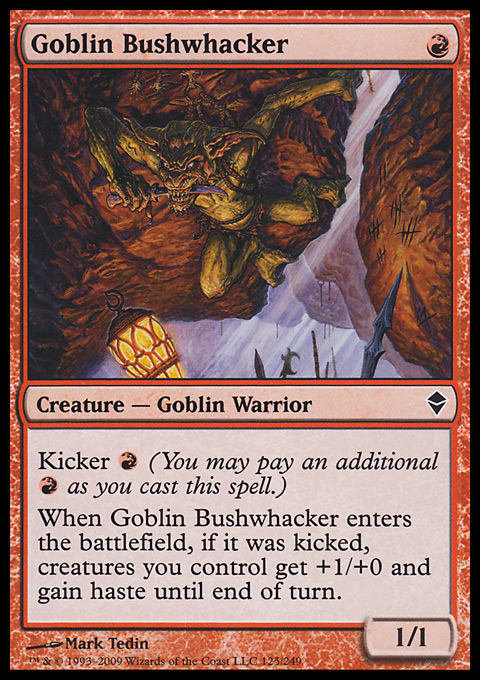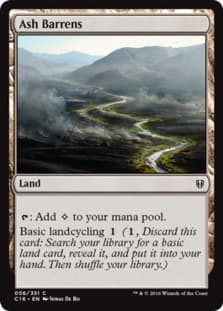Later this week, Pauper will be gaining access to a slew of powerful new cards thanks to Modern Masters 2017. Previous editions of Modern Masters made an impact, but they hardly warped the format. Rather, they provided useful tools for existing strategies without usurping the accepted order. The last set to turn things upside down was Eternal Masters and its resident mistake Peregrine Drake. Even after the ban of Drake, last year’s set still shapes the format thanks to Rally the Peasants and its presence in Kuldotha Tokens.
On average a new set does little to usurp the Pauper metagame. The inertia of the existing cardpool is so great it takes something that bucks the curve to have any sort of appreciable impact. If you have been following me recently, you know I believe that Modern Masters 2017 contains at least one such card in Burning-Tree Emissary. In turn, there are going to be plenty of people trying out new decks and strategies in an attempt to garner an edge on the format. Inevitably there will be players trying their hands at improving old strategies or trying out something brand new. With this in mind, I think it is important to take a look at building decks with an eye toward success in Pauper.
First I want to establish a working definition of deck for today’s article. A deck is not simply a collection of 60 cards that work in concert. When I talk about a deck today, I mean a regularly viable strategy for tournament Magic. I’m not trying to disparage you from building your Battered Golem — Banishing Knack — Ornithopter — Astral Steel deck, I’m just saying I do not think such elaborate decks can put up consistent results in the Online Pauper metagame.
So, now that we know what we mean when I say “deck”, we can begin.
In order to build a new deck one must have a basic understanding of the metagame. Thankfully in Pauper the top decks have remained relatively consistent for years. Delver, Stompy, and Affinity all put up consistent results. There are a few other major players that one must consider as well. Izzet Blitz, the Nivix Cyclops—Temur Battle Rage combo deck, and Hexproof both occupy a “go tall” space. Burn and other Red decks exist. Kuldotha Tokens and Elves both try to go wide and win with a flourish. The various Tron decks seek to use their overabundance of mana to establish a winning position. Finally, Dimir Flicker plays a one-for-one game until it can lock the opponent out with Chittering Rats and Ghostly Flicker.
While the metagame will change with the new cards, this still represents the starting point. These decks are not suddenly going to disappear overnight, and as such it is vital to understand that they will still comprise a decent portion of the field. The metagame provides us with our initial framework. The established lists also give us a chance to explore the Prime Directive.
The Prime Directive, as described as Patrick Chapin, is “Never play a bad something else.” Take another look at the above mentioned decks. While there may be some overlap in strategy and game plan, they are all distinct archetypes. They all approach the game from their own vantage point instead of attempting to replicate the plan of another strategy. To further illustrate this point, let’s take a look at two different aggressive Red decks.
Goblins ? Pauper | Swahili, 5-0 Pauper League
- Creatures (36)
- 1 Goblin Heelcutter
- 3 Jackal Familiar
- 4 Foundry Street Denizen
- 4 Goblin Bushwhacker
- 4 Goblin Cohort
- 4 Goblin Sledder
- 4 Mogg Conscripts
- 4 Mogg Raider
- 4 Mogg War Marshal
- 4 Sparksmith
- Instants (6)
- 2 Fireblast
- 4 Lightning Bolt
- Sorceries (2)
- 2 Reckless Abandon
- Lands (17)
- 17 Mountain
- Sideboard (13)
- 1 Goblin Caves
- 1 Goblin Heelcutter
- 2 Death Spark
- 2 Goblin Tinkerer
- 2 Smelt
- 2 Sylvok Lifestaff
- 3 Electrickery
Red Deck Wins ? Pauper| DarkHellkite, 5-0 Pauper League
- Creatures (32)
- 1 Mardu Scout
- 1 Sparksmith
- 2 Rakdos Shred-Freak
- 2 Valley Dasher
- 3 Goblin Heelcutter
- 3 Inner-Flame Acolyte
- 4 Goblin Bushwhacker
- 4 Goblin Cohort
- 4 Jackal Familiar
- 4 Mogg Conscripts
- 4 Mudbrawler Cohort
- Instants (6)
- 2 Fireblast
- 4 Lightning Bolt
- Sorceries (3)
- 1 Chain Lightning
- 2 Reckless Abandon
- Lands (19)
- 19 Mountain
- Sideboard (15)
- 2 Sparksmith
- 2 Death Spark
- 2 Electrickery
- 3 Molten Rain
- 3 Pyroblast
- 3 Smash to Smithereens
Both Goblins and Red Deck Wins are creature decks that want to attack early and potentially close out the game with spells like Lightning Bolt and Fireblast. Goblins uses tribal synergies to enhance its damage output as Mogg Raider and Goblin Sledder can force the issue. Red Deck Wins uses Haste creatures to try and get around removal.
When I first saw Red Deck Wins I thought it was a worse version of Goblins. Before Peregrine Drake decks took over there were a variety of removal spells that saw play. At this time I saw no reason to run Red Deck Wins over Goblins since it lacked a go wide Goblin Bushwhacker draw and ignored the strength provided by synergy. I considered it a worse version of Goblins. However as the metagame became flooded with copies of Flame Slash and Chainer's Edict then creatures with natural Haste rose in value and Red Deck Wins became the better version of the Mountain fueled beatdown deck.
The Prime Directive, in essence, asks us to play the best version of strategy at a given moment. Doing this means understanding metagame trends to understand when a deck is well positioned and when its time may be past. In the process of constructing a new deck it is vital to have a firm grasp of this concept so that one does not invest time in trying to build something new that is simply a weaker version of something that exists.
There is an important caveat here and that is you cannot reasonably expect to beat everything. I am known for playing decks that tend to have glaring weaknesses to certain facets of the metagame. I do this in order to try and get an advantage in certain other matchups. Does this violate the Prime Directive? If I were to be brutally honest with myself I would say “probably.” Gaining an edge on some matchups while losing value against the wider meta may pay off in the end. The important thing to keep in mind is to do it for an edge and not just to play something new.
Once you feel confident that you are not attempting to reinvent the wheel it is time to look at your potential foundation. The mana in Pauper is the best it has even been but it is still a significant limiting factor. The best decks tend to have rock solid mana bases that are able to consistently hit the correct untapped sources on ideal turns. The Khans of Tarkir Gain Lands help, as do Evolving Wilds and Ash Barrens, but they still pale compared to a pure Basic Land mana base. That is not to say you should avoid going into a second or third color, just that you need to be aware that this will slow down your strategy and put you in a reactive position more often.
Ignoring opposing deck speed is a mistake I see often in Pauper deck discussion. The speed at which the protagonist deck can deploy its game plan pulls focus, as it should, but often the conversation completely disregards what the other deck is trying to accomplish. Your mana must not only support you own strategy but it also cannot be a tool to be leveraged against you. There are exceptions to this rule — Molten Rain is not going to stop anyone from playing Urza's Tower — but the opportunity cost of lands cannot be a passing thought.
The final thing I want to talk about today is strength. Making sure your deck is strong enough to compete in the average game is the best way to remain competitive over a span of time. If a deck only works if the cards are drawn in a specific order then it may not be the most reliable stack of cards. These decks, the ones that need to see cards in a specific sequence, tend to be more synergy based. Synergy is fine; but, in Pauper, raw power is going to be better the majority of the time. Most decks have access to a haymaker — either a card or a sequence of plays that will end the game in short order — and knowing that your own knock-out punch is on par with the field can go a long way to shoring up victories in otherwise even games.
Haymakers include cards like Mulldrifter in Blue midrange decks or Fling in Affinity. Sticking the flying fish at parity can pull you ahead enough that victory is all but assured. Drawing Fling in Affinity can put you in a similar position where you only lose if your opponent has the right answer. Going back to Goblins, that deck’s best haymaker is probably Goblin Bushwhacker. This was good enough in the olden days, but that is no longer the case. The synergy present in Goblins is not enough to push the card over the edge. Fling, however, is just fine when it is taking a Myr Enforcer or Carapace Forger and turning it into a Fireblast.
Building decks with new cards is always exciting. Each set release provides a bevy of new options. Pauper, while having a well established field, is not immune from the allure of something different. When preparing your new build don’t forget to pick something strong, don’t lose to your mana, and, whatever else you do, don’t be a worse version of something else.

























